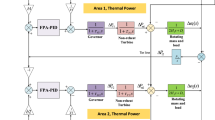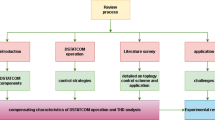Abstract
This study proposes a graphical user interface (GUI) based on an enhanced bacterial foraging optimization (EBFO) to find the optimal locations and sizing parameters of multi-type DFACTS in large-scale distribution systems. The proposed GUI based toolbox, allows the user to choose between single and multiple DFACTS allocations, followed by the type and number of them to be allocated. The EBFO is then applied to obtain optimal locations and ratings of the single and multiple DFACTS. This is found to be faster and provides more accurate results compared to the usual PSO and BFO. Results obtained with MATLAB/Simulink simulations are compared with PSO, BFO and enhanced BFO. It reveals that enhanced BFO shows quick convergence to reach the desired solution there by yielding superior solution quality. Simulation results concluded that the EBFO based multiple DFACTS allocation using DSSSC, APC and DSTATCOM is preferable to reduce power losses, improve load balancing and enhance voltage deviation index to 70%, 38% and 132% respectively and also it can improve loading factor without additional power loss.
Similar content being viewed by others
References
MENDOZA JORGE E, HECTOR E. Automatic voltage regulators siting in distribution systems considering hourly demand [J]. Electric Power System Research, 2011, 81: 124–1131.
ARUN M, ARAVINDHABABU P. Fuzzy based reconfiguration algorithm for voltage stability enhancement of distribution systems [J]. Expert System with Application, 2010, 37: 6974–6978.
FARHOODNEA M, MOHAMED A, SHAREEF H, ZAYANDEHROODI H. A comprehensive review of optimization techniques applied for placement and sizing of custom power devices in distribution networks [J]. Przegl A?d Elektrotechniczny (Electrical Review), 2012, 88: 261–265.
PHADKE A R, FOZDAR M, NIAZI K R. A new multi-objective fuzzy-GA formulation for optimal placement and sizing of shunt FACTS controller [J]. International Journal of Electrical Power and Energy System, 2012, 40: 46–53.
HOSSEINI M, SHAYANFAR H A, FOTUHI-FIRUZABAD M. Modeling of series and shunt distribution FACTS devices in distribution systems load flow [J]. Journal of Electrical System, 2008, 4(4): 1–12.
KALANTAR M. Active power line conditioner optimum placement using fuzzy controller [C]// IFSA World Congress and 20th NAFIPS International Conference. Vancouver, British Columbia, Canada: IEEE, 2001, 241: 245–250.
CHANG C S, ZHEMIN Y. Distributed mitigation of voltage sags by optimal placement of series compensation devices based on stochastic assessment [J]. IEEE Transactions on Power System, 2004, 19: 788–795.
SALMAN N, MOHAMED A, SHAREEF H. Reliability improvement in distribution systems by optimal placement of DSTATCOM using binary gravitational search algorithm [J]. Przegl A?d Elektrotechniczny (Electrical Review), 2012, 88: 295–299.
TAHER S A, AFSARI S A. Optimal location and sizing of UPQC in distribution networks using differential evolution algorithm [J]. Mathematical Problems in Engineering, 2012, 2012: 1–20.
FARHOODNEAA M, MOHAMEDA A, SHAREEF H, ZAYANDEHROODI H. Optimum placement of active power conditioner in distribution systems using improved discrete firefly algorithm for power quality enhancement [J]. Applied Soft Computing, 2014, 23: 249–258.
ZIARI I, JALILIAN A. Optimal placement and sizing of multiple APLCs using a modified discrete PSO [J]. International Journal of Electrical Power and Energy System, 2012, 43: 630–639.
TAHER S A, AFSARI S A. Optimal location and sizing of DSTATCOM in distribution systems by immune algorithm [J]. International Journal of Electrical Power and Energy System, 2014, 60: 34–44.
DEVI S, GEETHANJALI M. Optimal location and sizing of distribution static synchronous series compensator using particle swarm optimization [J]. International Journal of Electrical Power and Energy System, 2014, 62: 646–653.
VALIPOUR K, DEHGHAN E, SHARIATKHAH M.H. Optimal placement of capacitor banks and distributed generation for losses reduction and voltage THD improvement in distribution networks based on BBO algorithm [J]. IRJABS: International Research Journal of Applied Basic Science, 2013, 4(7): 1663–1670.
MIRHOSEINI S H, HOSSEINI S M, GHANBARI M, AHMADI M. A new improved adaptive imperialist competitive algorithm to solve the reconfiguration problem of distribution systems for loss reduction and voltage profile improvement [J]. International Journal of Electrical Power and Energy System, 2014, 55: 128–143.
MOHAMMAD H M, ZEINALZADEH A, MOHAMMADI Y, ABEDINI M. An efficient hybrid method for solving the optimal sitting and sizing problem of DG and shunt capacitor banks simultaneously based on imperialist competitive algorithm and genetic algorithm [J]. International Journal of Electrical Power and Energy System, 2014, 54: 101–111.
SZUVOVIVSKI I, FRENANDES T S P, AOKI A R. Simultaneous allocation of capacitor and voltage regulators at distribution networks using genetic algorithms and optimal power flow [J]. International Journal of Electrical Power and Energy System, 2012, 40(1): 62–69.
TORRES J, GUARDADO J L, RIVAS-DÁVALOS F, MAXIMOV S, MELGOZA E. A genetic algorithm based on the edge window decoder technique to optimize power distribution systems reconfiguration [J]. International Journal of Electrical Power and Energy System, 2013, 45(1): 28–34.
SULTANA S, KUMAR ROY P. Optimal capacitor placement in radial distribution systems using teaching learning based optimization [J]. International Journal of Electrical Power and Energy System, 2014, 54: 387–398.
NIKNAM T, GOLESTANEH F, SADEGHI M S. multiobjective dispatch teaching–learning-based optimization for dynamic economic emission [J]. IEEE Systems Journal, 2012, 6(2): 341–352.
SAHOO N C, PRASAD K. A fuzzy genetic approach for network reconfiguration to enhance voltage stability in radial distribution systems [J]. Energy Conversion and Management, 2006, 47: 3288–3306.
PRASAD P V, SIVANAGARAJU S, SREENIVASULU N. A fuzzy-genetic algorithm for optimal capacitor placement in radial distribution systems [J]. ARPN Journal of Engineering and Applied Sciences, 2007, 2(3): 28–32.
MORADI M H, ABEDINI M. A combination of genetic algorithm and particle swarm optimization for optimal DG location and sizing in distribution systems [J]. International Journal of Electrical Power and Energy System, 2012, 34(1): 66–74.
YILDIZ A R. A novel hybrid immune algorithm for global optimization in design and manufacturing [J]. Robotics and Computer-Integrated Manufacturing, 2009, 25: 261–270.
YILDIZ A R. An effective hybrid immune-hill climbing optimization approach for solving design and manufacturing optimization problems in industry [J]. Journal of Materials Processing Technology, 2009, 209: 2773–2780.
YILDIZ A R. A new hybrid artificial bee colony algorithm for robust optimal design and manufacturing [J]. Applied Soft Computing, 2013, 13: 2906–2912.
TABATABAEI S M, VAHIDI B. Bacterial foraging solution based fuzzy logic decision for optimal capacitor allocation in radial distribution system [J]. Electric Power System Research, 2011, 81: 1045–50.
SAADAT H. Power system analysis [M]. 2nd ed. London: McGraw-Hill Higher Education, 2009.
JEN-HAO T, CHUO-YEAN C. Backward/forward sweep-based harmonic analysis method for distribution systems [J]. IEEE Transaction on Power Delivery, 2007, 22: 1665–1672.
TENG J. A network topology based three-phase load flow for distribution systems [J]. Proceedings of National Science Council of China, Part A: Physical Science and Engineering, 2000, 24(4): 259–264.
JAZEBI S, HOSSEINIAN S.H, VAHIDI B. DSTATCOM allocation in distribution networks considering reconfiguration using differential evolution algorithm [J]. Energy Conversion and Management, 2011, 52: 2777–2783.
DEVI S, GEETHANJALI M. Optimal location and sizing determination of Distributed Generation and DSTATCOM using particle swarm optimization algorithm [J]. International Journal of Electrical Power and Energy System, 2014, 62: 562–570.
GHAZI R, KAMAL H. Optimal size and placement of DVR's in distribution system using simulated annealing [C]// 18th International Conference and Exhibition on Electricity Distribution (CIRED 2005). 2005: 75–82.
BLAZIC B, PAPIC I. A new mathematical model and control of DSTATCOM for operation under unbalanced conditions [J]. Electric Power System Research, 2004, 72(3): 279–287.
HINGORANI N. Introducing custom power [J]. IEEE Spectrum, 1995, 32(6): 41–48.
NILSSON S. Special application consideration for custom power systems [C]// IEEE Conference of Power Engineering Society. New York: IEEE, 1999, bol.2: 1127-1130.
ADYA A. Application of DSTATCOM for isolated system [C]// IEEE Region 10 Conference. New York: IEEE, 2004, 3: 351–354.
GHOSH S, DAS D. Method for load-flow solution of radial distribution networks [J]. IEE Proceedings on Generation Transmission Distribution, 1999, 146(6): 641–648.
HOSSEINI M, SHAYANFAR H A, FOTUHI M. Modeling of series and shunt distribution facts devices in distribution load flow [J]. Journal of Electrical System, 2008, 4(4): 1–12.
ACHA E, FUERTE-ESQUIVEL C R, AMBRIZ-PEREZ H, ANGELES-CAMACHO C. FACTS modeling and simulation in power networks [M]. New York: Wiley, 2004.
ZIARI I, LEDWICH G, GHOSH A, CORNFORTH D, WISHART M. Optimal location and sizing of capacitors to minimize the transmission line loss and to improve the voltage profile [J]. Computers and Mathematics with Applications, 2010, 60: 1003–1013.
SRINIVASAS RAO R, NARASIMHAM S V L, RAMALINGARAJU M. Optimal capacitor placement in a radial distribution system using plant growth simulation algorithm [J]. International Journal of Electrical Power and Energy System, 2011, 33: 1133–1139.
CHARKRAVORTY M, DAS D. Voltage stability analysis of radial distribution networks [J]. International Journal of Electrical Power and Energy System, 2001, 23(2): 129–135.
VOVOS P N, BIALEK J W. Direct incorporation of fault level constraints in optimal power flow as a tool for network capacity analysis [J]. IEEE Transactions on Power System, 2005, 20(4): 2125–2134.
BARAN M E, WU F. Network reconfiguration in distribution system for loss reduction and load balancing [J]. IEEE Transactions on Power Delivery, 1989, 4(2): 1401–1407.
KUMAR A, GAO W. Optimal distributed generation location using mixed integer non-linear programming in hybrid electricity markets [J]. IET Generation Transmission Distribution, 2010, 4(2): 281–298.
PASSINO K M. Biomimicry of bacterial foraging for distributed optimization and control [J]. IEEE Control Systems, 2002, 22(3): 52–67.
PATNAIK S S, PANDA A K. Particle swarm optimization and bacterial foraging optimization techniques for optimal current harmonic mitigation by employing active power filter [J]. Applied Computational Intelligence and Soft Computing, 2012, 2012: 897127.
BISWAS A, DASGUPTA S, DAS S, ABRAHAM A. Synergy of PSO and bacterial foraging optimization: A comparative study on numerical benchmarks [C]// 2nd International Symposium Hybrid Artificial Intelligent Systems, Advances in Soft Computing Series, innovations in hybrid intelligent systems, ASC Springer Verlag, Germany, 2007, 44: 255–263.
PATNAIK S S, PANDA A K. Optimizing current harmonics compensation in three-phase power systems with an Enhanced Bacterial foraging approach [J]. International Journal of Electrical Power and Energy System, 2014, 61: 386–398.
Acknowledgments
This work was supported by Islamic Azad University, Borujerd Branch, Iran. The authors would like to acknowledge staffs of University.
Author information
Authors and Affiliations
Corresponding author
Additional information
Foundation item: Project supported by Borujerd Branch, Islamic Azad University, Iran
Rights and permissions
About this article
Cite this article
Mohammadi, M., Montazeri, M. & Abasi, S. Bacterial graphical user interface oriented by particle swarm optimization strategy for optimization of multiple type DFACTS for power quality enhancement in distribution system. J. Cent. South Univ. 24, 569–588 (2017). https://doi.org/10.1007/s11771-017-3459-z
Received:
Accepted:
Published:
Issue Date:
DOI: https://doi.org/10.1007/s11771-017-3459-z




